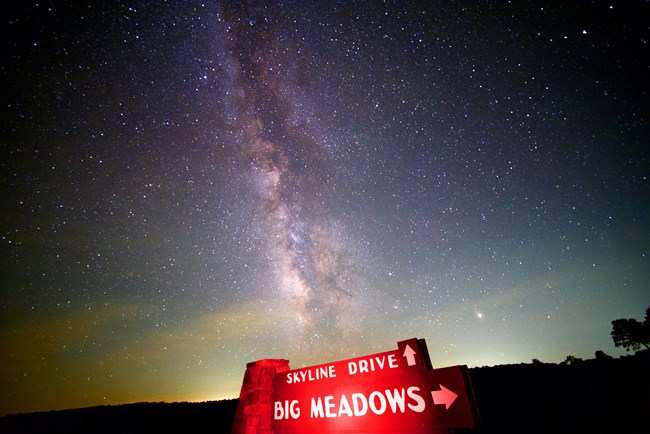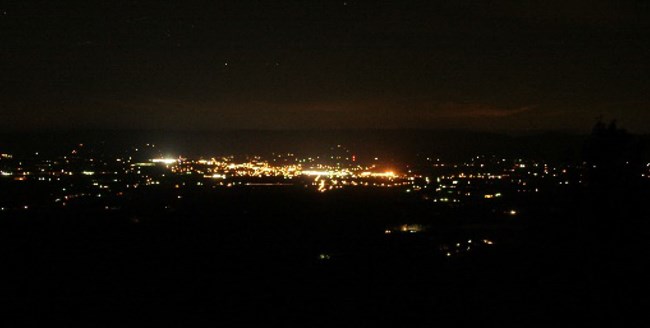
NPS/Mary O'Neill When you come home at night and flip on the lamp switch, do you ever stop to think about what you might be missing? 
Greg Redfern Tips for StargazingHere in Shenandoah, a good place for stargazing is by the Big Meadows area, near the Rapidan Fire Road. The amphitheater in the Skyland area is also appropriate. Allow your eyes time to adjust; it takes about twenty minutes for your eyes to become accustomed to the nighttime darkness. You may be surprised how well you can see by starlight. Make a red flashlight or use one with a red LED. To make your own, use red paper or cellophanes to cover the white light of the flashlight. Red light allows your eyes to adapt better to the darkness than white light while still providing visibility for safety. Enjoying the night skies is for everyone, you don’t need expensive equipment! If you don’t have a telescope, grab your binoculars to get a better look the fuzzy spots in the sky overhead. Also, use the binoculars to gaze upon the Milky Way. Educate yourself on the constellations overhead with the use of a star chart or a star finding app downloadable for your smartphone or tablet. When venturing out to stargaze in the park make sure to bring a red flashlight to journey from your car to your destination. Be sure to dress in layers, as summer nights are often cool on the mountain ridge. Bring a blanket or a set of chairs to sit on.

NPS Photo Unnatural Night LightThe proliferation of development and associated installation of lights, without thought to the impact those lights have on the night sky, is ongoing. Lighting associated with advertising, building and street illumination, and grounds security all contribute to what is referred to as light pollution. One estimate indicates that about 30% of all light generated in the United States is wasted; costing billions of dollars. Outdoor lights provide many benefits but improved consideration of night sky concerns in their design and application is highly beneficial in reducing light pollution and the associated wasted energy. In addition to interfering with our ability to see celestial bodies and astronomical events, light pollution has a detrimental environmental impact. Some believe that declines in moth populations are linked to attraction to lights and subsequent death. Nocturnal wildlife, especially prey, may be more vulnerable to predators at night if there is more artificial light. Many species of wildlife are influenced in their activities by star and moon light including some migratory bird species which depend on stars for navigation. Light pollution interferes with their travels, leading to disorientation and even death. The nocturnal creatures here in Shenandoah- owls, bats, and insects to name a few- benefit from the wide swath of forest that remains dark at night. The National Park Service is concerned about our contribution to light pollution and has set policy that seeks to reduce or eliminate the adverse impacts of light pollution. In October of 2014, Shenandoah National Park, as part of the National Park Service’s Night Skies Program, undertook a study to review how we use outdoor lighting and consequently implemented suggestions to make it more efficient. In most cases, improving night sky viewing opportunities involves reduction in light pollution so that people can see stars and planets above. Yet here at Shenandoah it’s also important to note that some of what would otherwise be regarded as light pollution is beautiful to people. Many park visitors stand at overlooks along Skyline Drive at night and view with warmth the twinkling lights of the small towns and communities in the Shenandoah Valley or the Virginia Piedmont. Oppositely, a visitor might look up at the Blue Ridge from the Valley and see only the dark strip of the Park, the silhouette of mountains blending into the evening sky, a reminder of a previous time before electricity. Regardless of how you might experience the night, don’t forget on occasion to look up at the skies! Night Skies in National Parks |
Last updated: August 11, 2025
